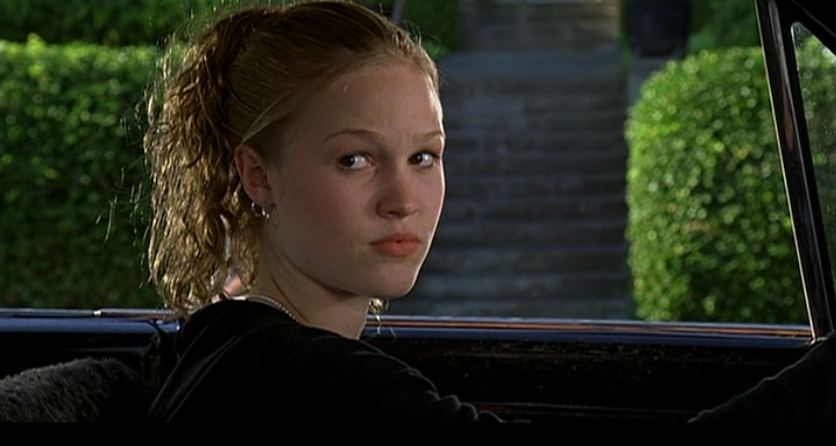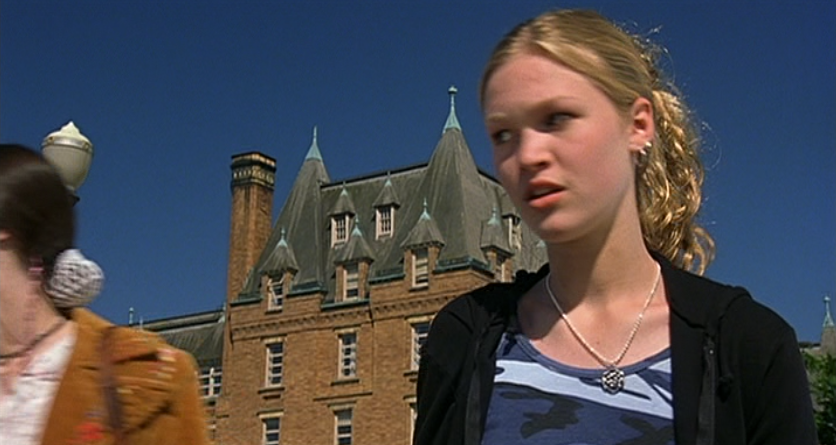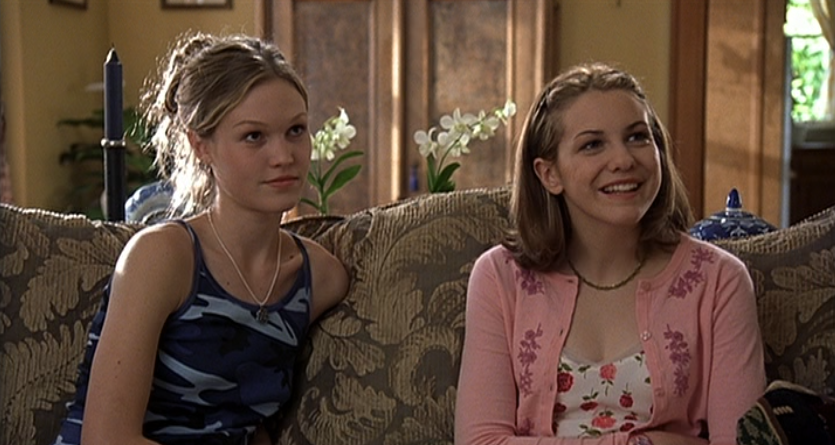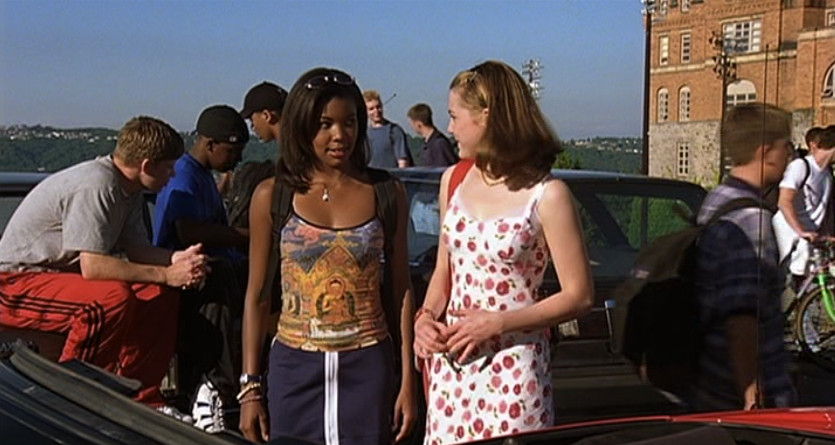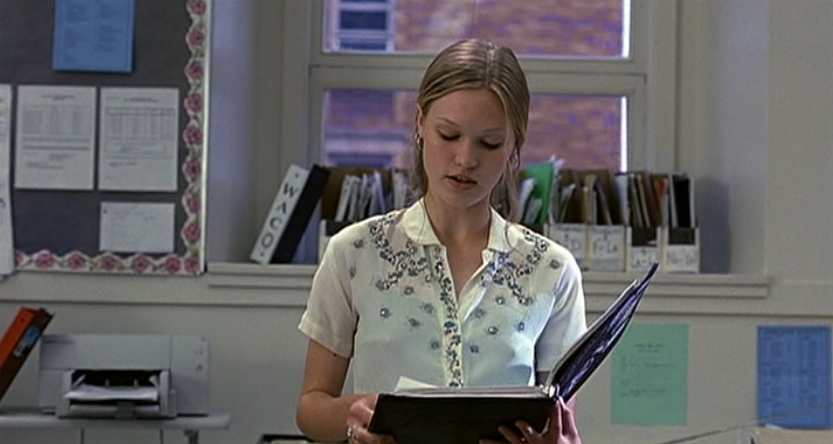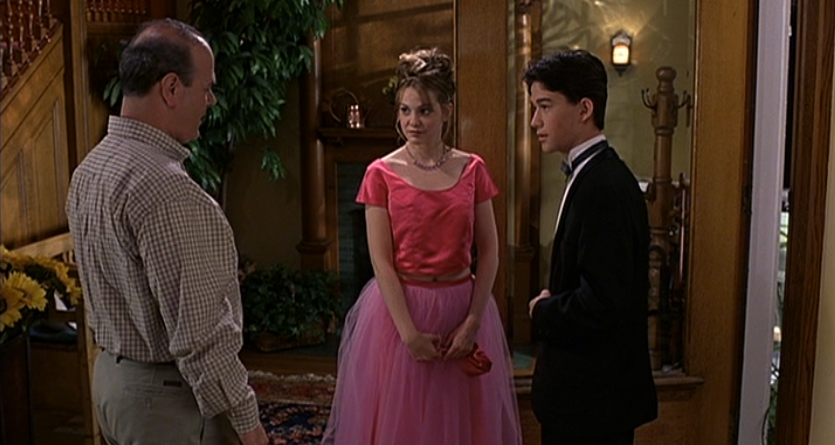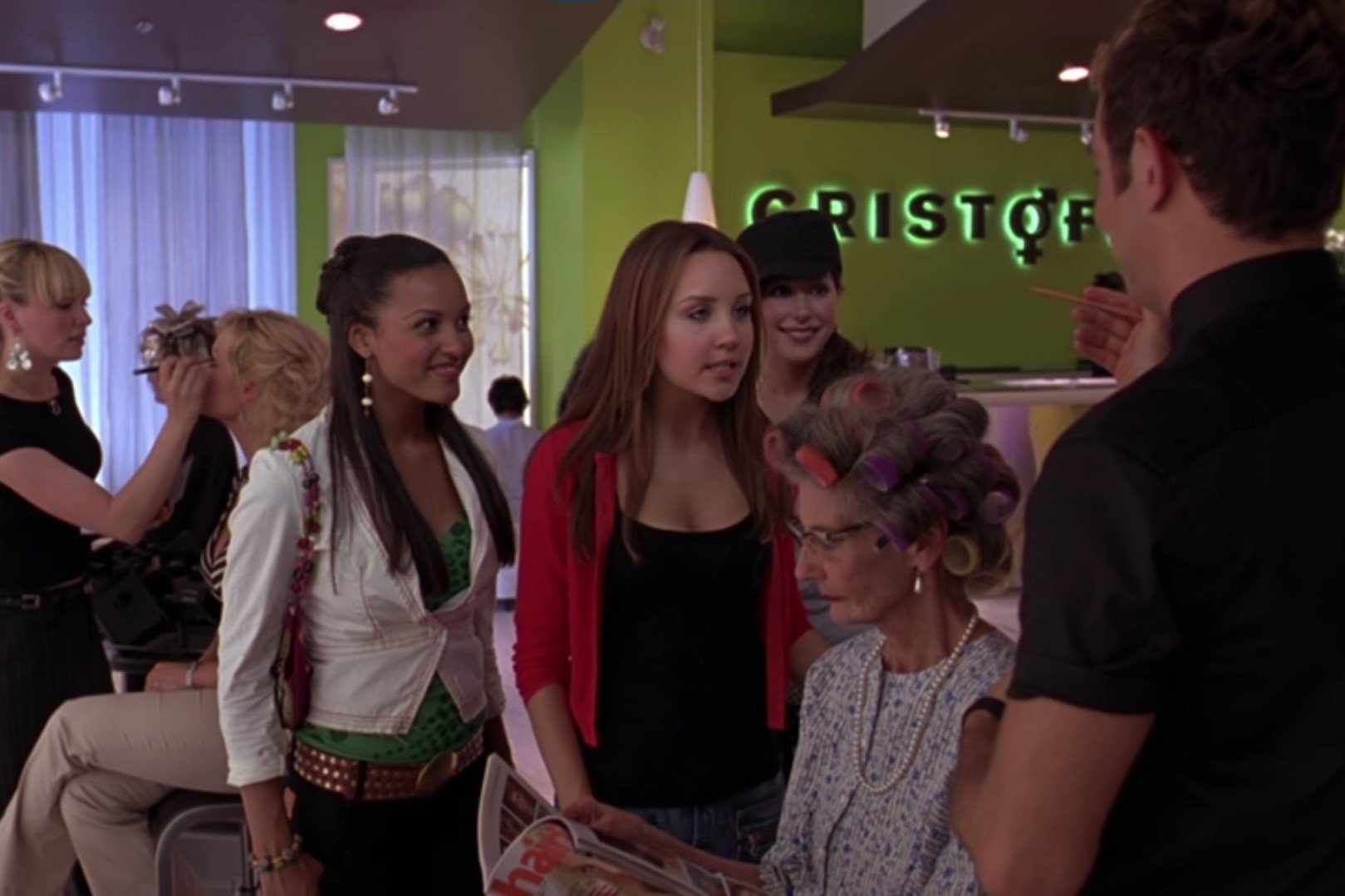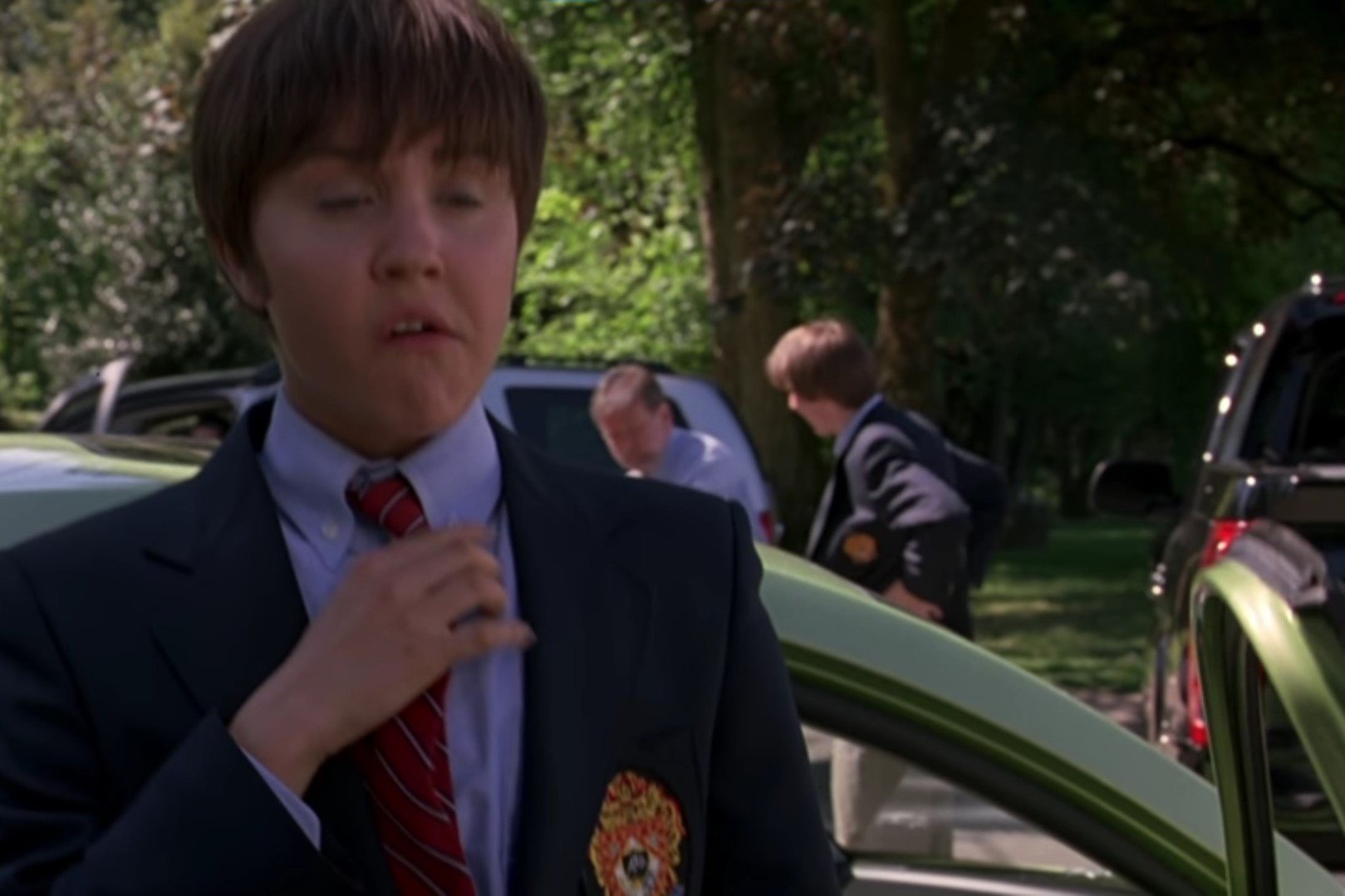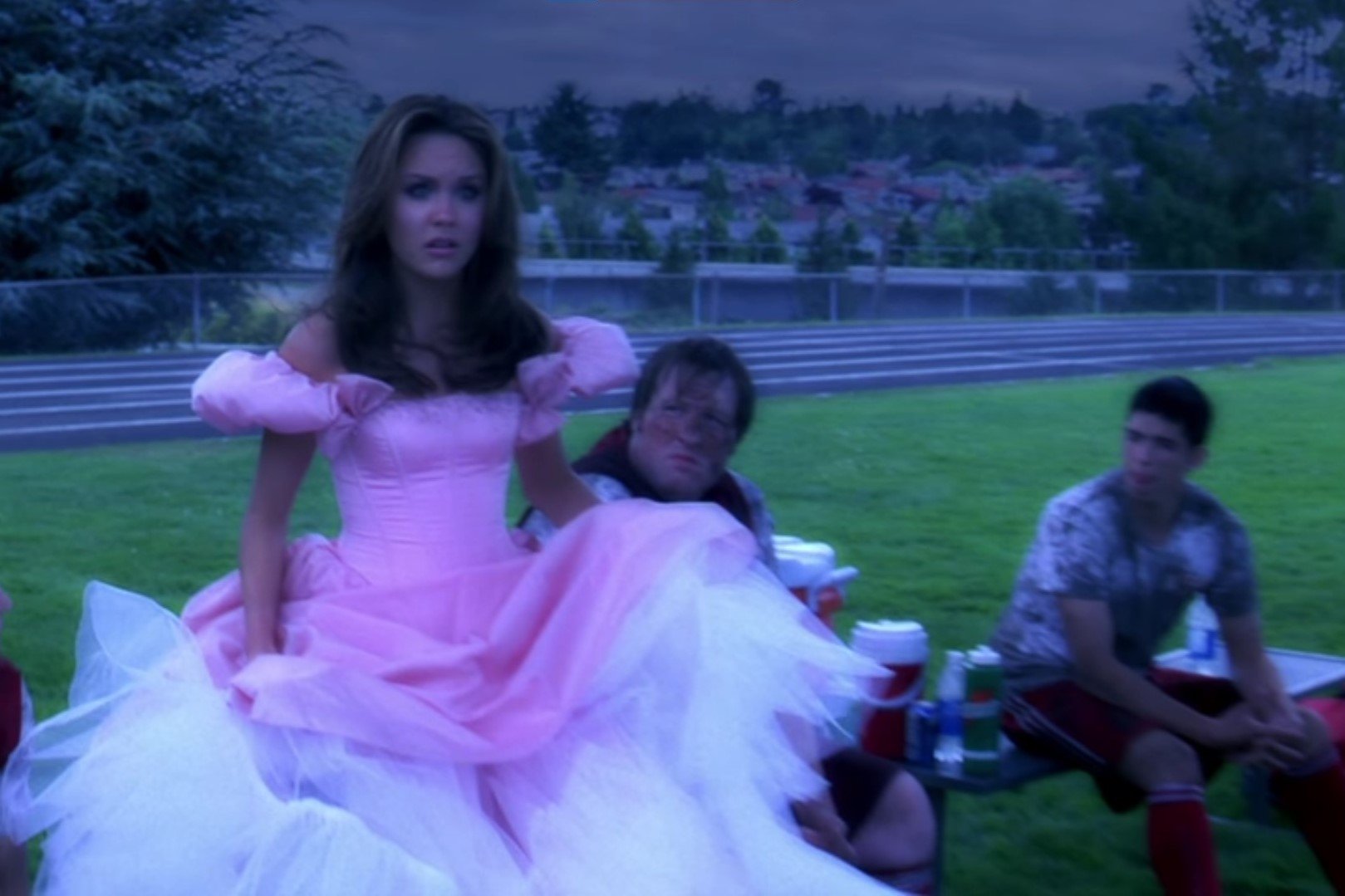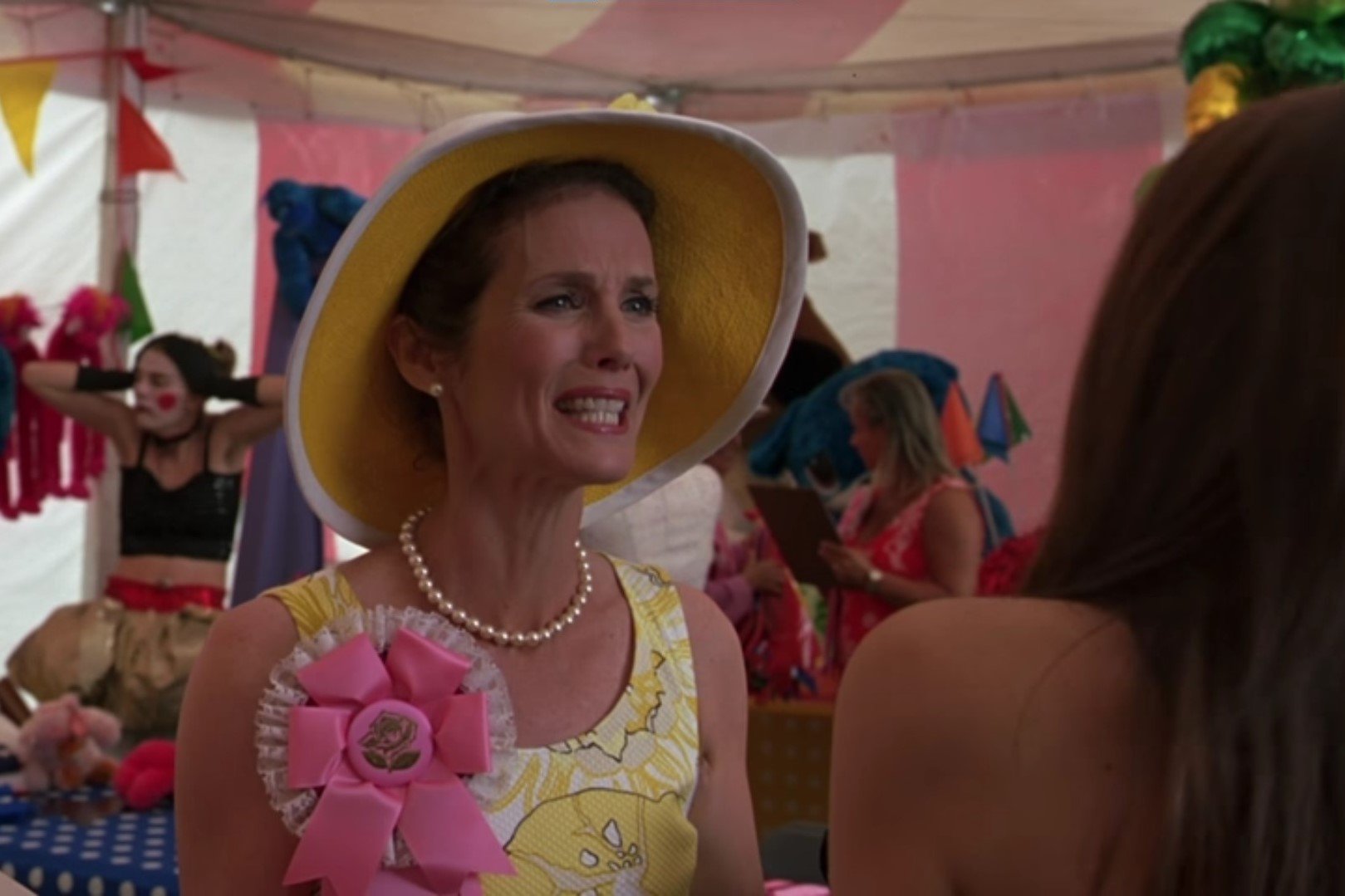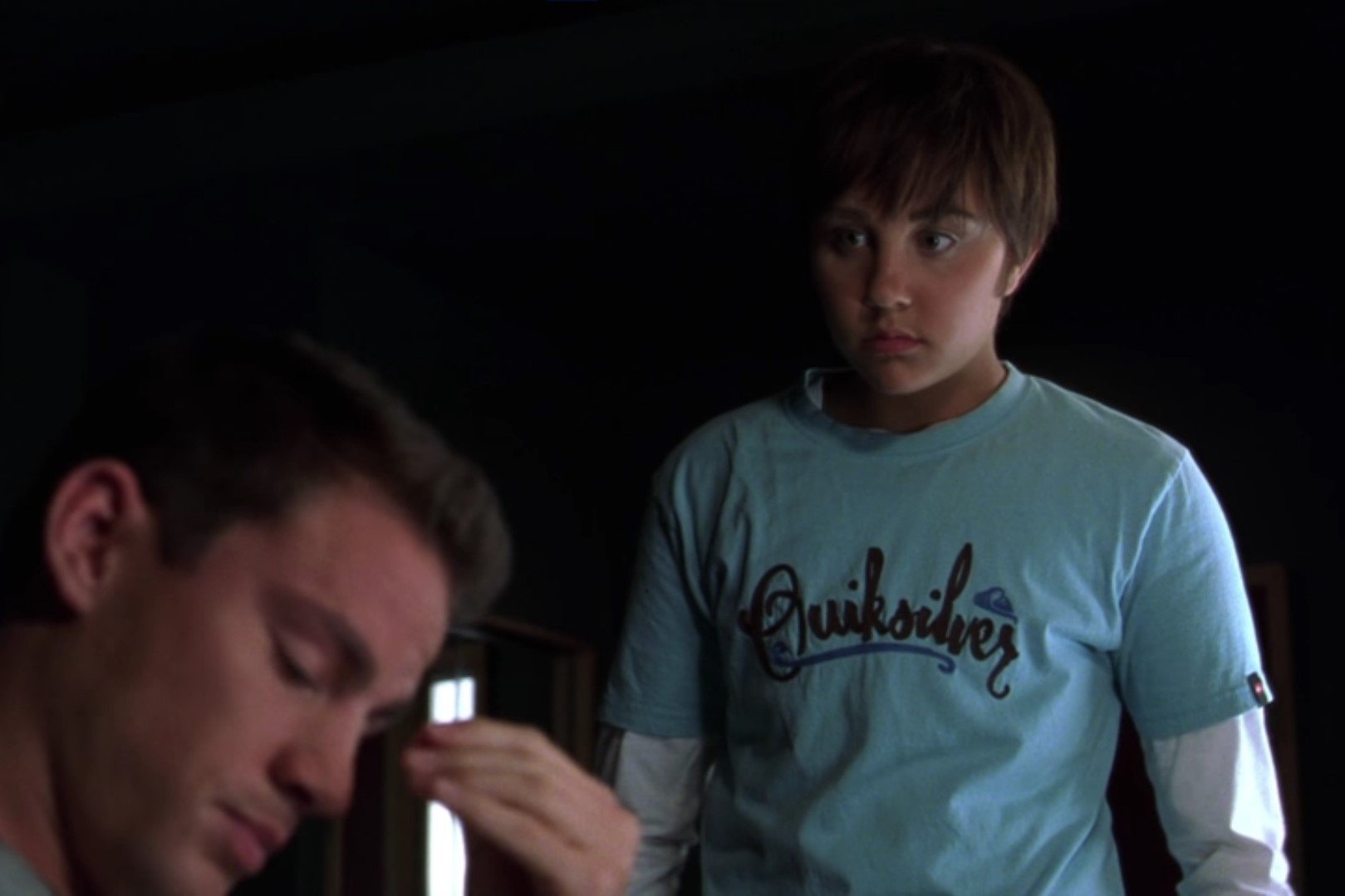Movie Night: 10 Things I Hate About You and She’s the Man
In Which Everything Is Shakespearean but Only One Person Wears a Snood
Originally published on Letterdrop 3/17/2022
For my last movie night, I wanted to do a double feature, and I couldn’t think of a more natural pairing than 10 Things I Hate About You and She’s the Man. Both are high school takes on Shakespearean comedies; both were adapted by Karen McCullah and Kirsten Smith (in between, they wrote a little indie flick called Legally Blonde). In the spirit of collaboration, I’ll be handling the costumes in 10 Things, while my partner, Daniel (whose quotes graced my Gossip Girl profiles), will discuss the costumes in She’s the Man. He is the sportier of us two.
10 Things I Hate About You
When I set about researching the costumes for 10 Things, I was pleased to find an interview with its costume designer, Kim Tillman, published for the movie’s twentieth anniversary in 2019. Let’s just say that no such articles existed for my previous movie night subjects—which is not a knock on their costume design but their cultural staying power. If/when 2026 comes around, I don’t think anyone will be wasting their one wild and precious life on twentieth-anniversary interviews for John Tucker.
10 Things takes the high school comedy to a farcical—hey, Shakespearean!—level. Compare the Mean Girls cafeteria scene with this 10 Things scene, in which Michael Eckman walks new student Cameron James through the high school’s cliques. Michael’s list starts off normal enough, with the “basic beautiful people,” then devolves into “coffee people . . . white Rastafarians . . . cowboys . . . [and] future MBAs.” Padua High School is an absurdist place, where the bad boy, Patrick Verona, doesn’t just smoke cigarettes and cut class but is rumored to have sold his liver and spent time in San Quintin. The guidance counselor, Ms. Perky, isn’t just ineffectual, she spends most of her workday openly writing a torrid romance novel. Cameron, an outsider to this world and the audience’s proxy, doesn’t quite know what to make of it.
The film’s costumes serve to remind the viewer of the modern setting—no character, with two notable exceptions, goes full-on Elizabethan—while still highlighting the quirks of its players.
From her very first look, we know exactly who Kat Stratford is. She pulls alongside a carful of teen girls, all bopping along to the Barenaked Ladies’ “One Week.” Kat’s Joan Jett drowns out their music, her black zip-up hoodie contrasting with their pigtails and playful prints (they look, as we’ll soon see, a lot like Kat’s little sister, Bianca). Jett’s lyrics perfectly introduce Kat’s character: she does have a bad reputation, and she doesn’t give a damn.
As Tillman told HelloGiggles, Kat is “artistic, and a bit rebellious, and kind of [has] to look a little bit like she [doesn’t] give a shit.” She is, I can’t help but notice, a proto–Veronica Mars. Much like Veronica, Kat toughens herself up in cargo pants, camouflage, a canvas cross-body bag; in black and muted blues, purples, and greens; in repeat silver jewelry, worn almost like talismans (in Kat’s case, a chunky silver ring and silver hoops in multiple piercings).
Kat is the titular “shrew” but through a modern lens—the issue is not with the woman but with the society (or high school) that judges her for not being sweet and compliant. She has no interest in winning her peers’ acceptance, in dating the most popular guys; she just wants to graduate and get across the country, to her dream college, Sarah Lawrence, where she can read The Bell Jar and blast Bikini Kill to her heart’s content.
Apologies for the crappy pictures; it was hard to get a good look at Mandella’s outfit.
Kat’s best friend, Mandella, is equally uninterested in fitting in but has slightly less contemporary obsessions. In a cheeky nod to the story’s origins, Mandella is in love with William Shakespeare, her wardrobe a nineties take on the sixteenth century. In her first scene, for example, she wears a red crochet corset over a white blouse, a snood over her bun.
Kat’s little sister, Bianca, is still playing the popularity game, crushing on resident douchebag Joey Donner. Where Kat’s clothes are supposed to make her look hard and unapproachable, Bianca’s are meant to make her look soft and romantic. When Cameron first sees and falls in love with Bianca, she floats across the courtyard in a white-and-pink floral dress, beaded necklace, and red satchel. Her color palette is red and pink, like a big Valentine, with touches of white to contrast her with Kat and remind the viewer of her name meaning and virginal status. (Later on, Bianca believes a pair of black underwear signals that Kat is interested in having sex.) At home, Bianca adds a pink cardigan—a concession, I imagine, to her conservative father.
Bianca shares her fashion obsessions with her best friend, Chastity. (As Bianca explains, she knows the difference between like and love because “I like my Sketchers, but I love my Prada backpack.”) Still, Chastity’s wardrobe is a little more sporty—a track skirt with a printed tank, a printed dress with track stripes up the sides and a zip-up hoodie—hinting, as we’ll later confirm, that her loyalty lies more with Joey than Bianca.
Cameron (left) and Michael (right)
Cameron’s new friend, Michael, tries to dissuade him from Bianca; Mr. Stratford doesn’t allow his daughters to date. Michael is a former “future MBA,” kicked out of the clique for allegedly buying his IZODs at an outlet mall. He and his ilk favor a professional wardrobe of khakis, button-downs (for Michael, mostly in blue), and briefcases; Michael even tries to wear a necktie to a rager. The future MBAs’ preppy brands, like Ralph Lauren and the aforementioned IZOD, are their calling cards. (Funny, then, that Michael judges Bianca for her Sketchers and Prada line. You’re as brand obsessed as she is, Michael!)
Cameron is less image conscious than his peers; as Tillman described him, he is “cool and understated,” usually wearing an “oversized” printed button-down or flannel over a T-shirt and slacks, his color palette greens, browns, oranges—earthy and grounding.
After Mr. Stratford changes the house dating rule—Bianca can date when Kat does—Cameron and Michael hatch a plan: they’ll hire the baddest boy in school, Patrick, to date Kat, and they’ll use Joey as a front for the money.
Joey (left) accepts his friend’s bet.
Joey wants to go out with Bianca, too, but only because he’s bet a friend that he could have sex with her. His look is a blend of louche and sporty: button-downs open over undershirts, track pants, polo shirts; his color palette white with dashes of black, burgundy, and blue; his hair greased back. On Joey, white reminds us of his single-minded goal—Bianca’s virginity—and juxtaposes him with his least favorite people: Kat and Patrick.
Like Heath Ledger, Patrick is Australian, and Tillman wanted his style to be “a little bit different,” full of “fitted V-necks and even latex pants.” He may not look or sound like the rest of Padua, but he’s a perfect stylistic counterpart to Kat: he favors the same silver jewelry, canvas cross-body bags, and darker colors—navy, gray, black—that she does. They intimidate everyone except for each other, though Kat is slow to trust Patrick. (I suspect his undershirt and button-down combo reminds her of Joey.)
At its heart, 10 Things is as much a story about sisterhood as it is about first love. As Bianca spends more time with Cameron, as Kat opens herself up to Patrick, their color palettes start to wink at each other’s. Bianca is becoming less superficial and image conscious, like Kat, and Kat is becoming more romantic and openhearted, like Bianca. (They are, in some ways, a modern Elinor and Marianne.)
When Bianca helps Cameron learn more about Kat, she wears a pale blue floral tank and white jeans. The day after Bianca kisses Cameron, she comes to school in a blue T-shirt and blue floral skirt. (But when he doesn’t ask her out immediately, she’s back to furious red.)
On her paddleboat date with Patrick, Kat dons a red sweater. When she cries while reading a poem she wrote about him, she wears a white floral blouse. At their most transformative moments, the sisters are in each other’s colors.
Fittingly, one of the sisters’ biggest conflicts comes over a piece of jewelry. Kat and Bianca’s mother left three years ago, and their father just found her pearl necklace in a drawer. When Kat sees Bianca wearing the strand, she’s livid. The pearl necklace is more than an accessory, it’s an aching for their absent mother, a reminder of the moment when Kat’s world changed. After their mother left, Kat slept with Joey for the first time; he dumped her for not wanting to have sex again. When Kat says the necklace doesn’t look good on Bianca, she isn’t talking about the pearls so much as the heavy dose of reality that Bianca will get if she continues to pursue Joey.
By prom, Kat has told Bianca about her past with Joey; Bianca even punches Joey on the dance floor. Thus, it’s not Bianca but Kat who is wearing their mother’s pearl necklace with her prom dress—a sign of their renewed sisterly bond and a reclamation of the pain that has guarded Kat’s heart for three years. For at prom, Kat finally finds out that Joey paid Patrick to take her out—and Patrick confesses that he cared about her, not the money.
Tillman saw the sisters’ prom dresses as the “culmination of the romances . . . their true, romantic selves,” and so she designed them with each sister’s style and signature color in mind. Kat’s is a “steely blue” spaghetti-strap number, “a sophisticated, simple look for a girl who’d been wearing army pants.” (Her date, Patrick, is equally simple yet subversive in a black tux with no tie.) Bianca’s is a pink crop top and tulle skirt, “playful and sweet”; her date, Cameron, in a classic black tux and bow tie.
The Stratfords’ friends also find their romantic equals: Chastity attends prom with Joey, and her gray snakeskin sheath feels like a nod to her snake-in-the-grass friendship with Bianca. (Turning the only named character of color into a backstabber is indeed one of the ten things I hate about 10 Things.)
Mandella wears a vaguely Elizabethan dress that Michael gave her, Michael in a red jacket and white lace jabot. Frankly, neither seems quite period accurate, but I expect Michael did his best; like the equally cynical Kat, he’s gone from cool blue to romantic red. Mandella and Michael’s prom wear is a sartorial nod to the source material; at the end of a Shakespearean comedy, everyone ends up with the right people.
Oh, and if you’re having a bad day, go watch Heath Ledger sing “Can’t Take My Eyes off You.” Hey, even if you’re having a good day, go watch it. I’ll see you in June for Gilmore Girls! Now, I’ll send it over to Daniel, with sports.
She’s the Man
Released in 2006, She’s the Man was the third project inspired by Twelfth Night in about twenty years: first came the 1985 film Just One of the Guys, loosely turning the story into a high school, and then the 2001 Disney Channel Original Movie Motocrossed, which shares the “Shakespeare + Sports” strand of DNA with She’s the Man, albeit of a more extreme variety.
The basic premise of all three movies is pretty straightforward: instead of a shipwreck separating a pair of fraternal twins and leading the sister of the pair to enterprisingly dress as a young man to survive (as in Shakespeare), said sister joins a rival high school (or, in the case of Motocrossed, BMX crew) to prove she belongs in a predominantly male world. In She’s the Man’s case, that world is soccer, in an era when U.S. women’s soccer boomed (with the 1999 World Cup–winning USWNT team) and went bust (with the dissolution of the short-lived Women’s United Soccer Association three years before the film’s release). Just as American women were trying to prove they belonged on the soccer pitch, so was Viola Hastings.
Twelfth Night is a story that relies on gender essentialism, and does She’s the Man ever lean into it: a key moment in the third act of She’s the Man amounts to “guys have dicks and girls have boobs.” Boys and girls—and men and women—operate almost solely in homosocial worlds in She’s the Man, separate “teams” in life, which leads them to don uniforms on field and off.
The film begins with a beach party montage featuring Viola and her boyfriend, Justin, Viola engaged in a soccer match and Justin cheering her on. Viola wears a bikini and a Livestrong bracelet; one could argue that this is the film showing her genuine identity, feminine and athletic. (But it could just be that it was 2004-ish and everyone was wearing those wristbands.) We learn from Justin that Viola’s soccer skills are improving and that she’s likely better than half the players on his team.
We then cut to the training grounds at Cornwall Academy, where Viola and her teammates are walking to practice. Viola and her friend Kia are discussing colleges; Kia thinks Viola could get more playing time on a team like the University of Michigan’s, but Viola has her sights set on the powerhouse University of North Carolina, real-life alma mater of such stars as Kristine Lilly, Cindy Parlow, and Mia Hamm.
As Viola imagines four years in Carolina blue, the Cornwall girls’ team has the colors to match: white shirts with a thin black stripe and light blue side panel, black shorts with a thin white stripe and gray side panel, and black socks. Cornwall’s kits are even manufactured by Nike, athletic apparel suppliers to UNC since the 1990s. Viola is already on the path toward her goals.
But Viola soon learns that practice is canceled, the girls’ soccer team disbanded due to an insufficient number of players. Their abandonment is almost foreshadowed by a lack of a Cornwall crest on the team’s uniforms: the girls are on their own.
Contrast their uniforms with Justin’s training goalkeeper kit (Cornwall’s crest at the center of his shirt). You can see the disparity of resources here: while Viola and her teammates essentially get generic Nike team wear, Cornwall’s boys’ team has personalized gear even for practice.
Viola asks the suntanned Coach Pistonek if she and the girls can try out for the boys’ team but is rebuffed: Pistonek believes that girls are simply slower and less athletic than boys, and Justin agrees (casually gaslighting Viola by claiming he never said she was better than some of the boys on his team). Viola dumps Justin on the spot.
As Viola returns home in a hoodie, ball cap, and earbuds, sad after her team’s dissolution and her recent breakup, she’s trailed by Monique—thinking she’s Viola’s brother, Sebastian, with whom Monique is in a relationship.
Monique—full of sequins, lace, cleavage, and checkered purses—remarks on Viola’s “total lack of curves”; from the back, she says, the twins look practically identical. And thus a plan is hatched. . . .
But not until Viola finds her mother waiting at the front door for her arrival, in a light blue outfit far unlike Viola’s soccer uniform (though not unlike what, say, Nancy Reagan would wear).
She’s a member of the Stratford Junior League, about to show Viola some gowns (beautiful gowns) for the debutante ball. Viola doesn’t want any part of her debut, citing a “no ruffles” policy for her outfits.
Viola takes after Sebastian, who is setting off for London for a festival gig (unbeknownst to their divorced parents) and wearing the uniform of the 2000s emo boy: band T-shirt (in this case, Violent Femmes) and contrasting long-sleeve underneath. As he climbs with his gear out the window, he asks Viola to conspire with him as he’s absent for the first two weeks at his new school, Illyria Preparatory Academy. (Yes, Cornwall, Stratford, Illyria—there’s a theme in the place names.) While Sebastian’s idea of coverage likely differs from Viola’s, Viola takes this as an opportunity: no one knows Sebastian at the new school, so she can pose as her brother and win a spot on the Illyria boys’ soccer team in time to take on their rivals, Cornwall.
To do this, she’ll need to bring in her friend Paul, a hairdresser and, it seems, a wigmaker. I could spend a bit of time talking about Paul, the subtly but clearly gay friend of Viola, Kia, and Yvonne (at left in the screenshot above), who serves at different points in the film as Viola’s costumer, driver to Illyria, and almost theatrical director (when trying to reframe “Sebastian” as a ladies’ man). But I’ll leave it at the logo of the salon where he works, Cristofer, complete with a combined male and female sign in place of the O, a classic symbol of androgyny or gender nonconformity: a perfect way of describing what’s to come for Viola as “Sebastian.”
(Here is a good point to say that She’s the Man was part of a rough and almost dysphoric time for Bynes, per her 2018 “Break the Internet” interview with Paper magazine. “I went into a deep depression for 4–6 months because I didn’t like how I looked when I was a boy,” she said; seeing herself in that role was “a super strange and out-of-body experience. It just really put me into a funk.”)
As Viola sets the final stage of her plan, she bids goodbye to her mother, saying she’s going to stay with her father and brother (and Monique) for the next two weeks, all while wearing her Livestrong wristband and a light blue shirt (again, a Tar Heel tie-in).
Of course, she’s not going to her father’s house but to Illyria, where “Sebastian” is already bedecked in uniform: a tie in the school colors of “charcoal black and candy-apple red” (in the words of Headmaster Gold), a blazer with the school crest on the left breast, a light blue shirt, and khaki pants. Much as the school uniform is a costume to promote respectability and professionalism, “Sebastian” uses it as a means of cloaking his (her?) true self.
Yet there’s a great deal of variation in the uniform at Illyria (seen here in this screenshot, between the blazer, sweater vest, cardigan, and polo combinations)—and so too in the opportunities to explore identity. Unlike rigid Cornwall, Illyria has more room for Viola to find her way.
I do want to take a moment here to say that it irrationally bugs me that the Illyria band has a completely different shade of red (almost a maroon) compared with the school crest or the soccer uniforms (which we’ll see later) or even the banner in the background.
Yet the band outfits match the color of the orientation folder—but differ from the red and black of the banners behind them! Illyria Academy, fix your branding guide!
After a disorienting trip through the dormitory halls (as boys roughhouse and throw stuff), “Sebastian” finds his dorm room, which he will share with Duke Orsino (Channing Tatum in his first big role—Bynes, in fact, campaigned for him to be cast, per her 2018 interview with Paper), and where he also meets Duke’s teammates, Andrew and Toby. I love that the posters immediately place the film in time: Frank Lampard in the 2003–5 Chelsea home kit and Eddie Gaven of the New York/New Jersey MetroStars, fresh off a Best XI season at the age of seventeen and wearing their AC Milan–inspired red-and-black striped shirts, matching Illyria’s school colors. (Eddie Gaven is—almost to the day—six and a half years younger than Channing Tatum; this is definitely one of those “adults playing teens” movies.)
“Sebastian” goes to soccer team tryouts the next day, where the Armadillos are led by Coach Dinklage (soccer “hard man” turned actor Vinnie Jones, playing himself in all but name). Coach and team are clad in Adidas team wear, the team’s kits made up of white shirts with red stripes (and an “Illyria Soccer” script where a crest should be), red shorts, and red socks. Vinnie wears a black Adidas tracksuit, completing the outfit with a stopwatch and clipboard. Vinnie Jones means business.
After a hard-fought tryout, missing out on a first-string spot, “Sebastian” is spared having to shower with the rest of the team when he’s beckoned to a meeting with Headmaster Gold. The headmaster wears his own costume of a suit with a red (sometimes patterned, sometimes solid) bowtie and pocket square, and usually a checked shirt. While Viola uses her “Sebastian” disguise to mask her femininity, Gold uses his outfit to show his power, despite his general incompetence and lack of tact. As a one-time transfer student to Illyria himself, Gold keeps a keen eye on “Sebastian,” even briefly serving snacks at the campus dining hall.
Meanwhile, Viola has to balance two lives—trying to fulfill her mother’s Junior League dreams (both at their carnival fundraiser and as a debutante) and trying to win a first-string spot on the Illyria squad. Her double life leads to a dream sequence in which Viola, in one of the gowns her mother picked out for her, has to take the field for Illyria as a mid-game substitute, missing a key shot against Cornwall and her ex-boyfriend keeper Justin. (Note the washed-out colors, reminiscent of the Veronica Mars dream sequences in volume two, essay five of this newsletter, true believers.)
At the carnival, Viola has to switch between personae multiple times, causing the love triangles among Viola and Duke (who share their first kiss at the carnival kissing booth, which I truly hope is an anachronism), “Sebastian” and Olivia, Duke and Olivia, “Sebastian” and Monique (fully in the “crazy ex-girlfriend who won’t take no for an answer” archetype at this point), and Viola and Justin (who has switched on “possessive ex-boyfriend” mode) to converge and intertwine. Meanwhile, Viola’s mother seems to have won a major award.
Later on, at one of the Junior League’s luncheons for debs-in-training, Viola enters late wearing a white dress and denim jacket, one more masculine identity cloaking the other more feminine identity.
Meanwhile, “Sebastian” is about to be found out: Malcolm, the Malvolio of the film (his pet tarantula is so named in honor of the original role. BTW, who lets a boarding school student have a pet tarantula?) overhears Viola speaking on the phone with her mother and does some digging. He learns that “Sebastian” has a twin sister.
The real Sebastian arrives early in Illyria, the night before the big match against Cornwall. Olivia, fully smitten with “Sebastian,” runs to the real Sebastian’s taxi and plants a kiss on him, reciting lyrics “Sebastian” brought with him to campus before running off. Duke sees this kiss and thinks “Sebastian” has been using him. When “Sebastian” returns to their room, clad in pretty much the exact same outfit Sebastian wore when leaving for London (white long-sleeve under a light blue Quiksilver T-shirt), Duke kicks him out. “Sebastian” oversleeps in nerdy, orthodontia-clad Eunice’s room, and the real Sebastian (who is awful at soccer) unknowingly takes his sister’s starting place on the team.
The next morning: match day. Illyria apparently has the funds to put up vinyl signs for the visiting sides every home match. I can’t imagine how high the tuition is here.
The Illyria players are decked out in face paint and their honestly boring home kits: red shirts with white stripes, big white block numbers, and the “Illyria Soccer” crest; red shorts with white stripes; and white socks. Part of the budget for a more custom kit must have gone to the warm-up jackets and pants (and the whole scoreboard vinyl thing).
Just before kickoff, we see the Hastings parents, looking like they’ve just flown in from Newport for the match. (Viola and Sebastian’s father may as well have, considering to this point he’s just been a plot device.) Their wealthy white tastes are out of place at a soccer match, even one between two prep schools.
Then, out come the Cornwall Griffins, in blue shirts with white piping, black side panels, and black block numbers, “Cornwall” front and center below the Nike maker’s mark; blue shorts; and black socks. It’s a classic football matchup of red versus blue. The Cornwall captain, Justin, wears an orange-and-gray keeper shirt and long black pants, with “Griffins” on his shoulders and “Cornwall” at his heart.
The Illyria goalkeeper has even more flair, with a purple/pink/gray camo shirt featuring black shoulders and even a black polo collar! René Higuita would be proud.
Kickoff commences, Sebastian proves he has two left feet, and Vinnie Jones benches him. Meanwhile, Malcolm (in a preppy yellow polo) and Monique (in a pink velour tracksuit) join Gold in storming the field to announce that Sebastian “is a girl.” Cue sex/gender conflation scene number one, in which Sebastian shows his junk to Malcolm (and the crowd) to prove him wrong.
At halftime, Viola switches places with Sebastian and gets Vinnie Jones to give “him” one more chance. After the teams each give up a goal, Duke and “Sebastian” have it out on the field, leading to a full-fledged brawl (even down to the mascots). Finally, “Sebastian” tells Duke, the Illyria side, Justin, and the stadium that she is, in fact, Viola (taking off her prosthetic sideburns and eyebrows, removing her wig to reveal her long hair, and flashing everybody as proof).
Viola pleads to Duke, who recites the “be not afraid of greatness: some are born great, some achieve greatness, and some have greatness thrust upon them” line from Twelfth Night in welcoming her to the team, a reversal of Justin’s behavior at the beginning of the film. But Coach Pistonek calls for a forfeit; the subsequent dialogue (and the costumes) exemplify the differences between the two coaches. Pistonek is breezy, sun-kissed, and careless (wearing shirtsleeves and a tie for the match); he’s just here for a job. Vinnie Jones is clad in an all-black suit and shirt with no tie—demonstrating toughness and masculinity but also a willingness to buck the trend. And he certainly does, telling Pistonek (in this classic scene) that Viola is here to stay on the team.
Just as the match is seemingly doomed to a draw, Viola is tackled by a Cornwall player. The referee awards a penalty (despite Pistonek’s protestations), and Viola and Duke combine on a trick play to score the match winner, sending Justin off crying.
The video evidence proving that the Cornwall defender completely missed the ball
As the match (and film) concludes, our fated couples find each other: Sebastian and Olivia, Eunice and Toby (who harbors a longtime crush on her), even Viola and Sebastian’s parents, who seem to have a reconciliation. And of course, at the debutante ball, Duke and Viola.
The last two scenes show Viola in her two uniforms, again representing her genuine self: as both an athlete and as a girl, without ruffles and now without disguises.
Daniel is a nonprofit manager, tour guide, NJ/NY Gotham FC supporter, and—most pertinent to this newsletter—Chrisinda’s partner. You can find more information about his historical walking tours at history.works.

